The rowing machine and the treadmill are both excellent cardio machines that deliver a lot of results. But which one will work best for you? Read on and choose the right machine for your goals.
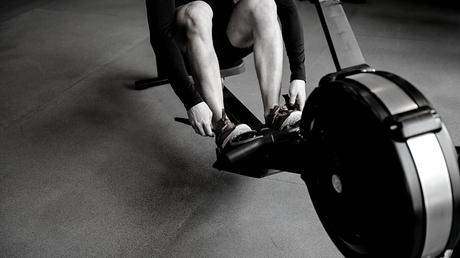
If your gym or home gym has a lot of different cardio machines, it can be tough to know which is the best for you to use.
On the one hand, the treadmill seems like the most practical choice—after all, we should all be training to run more, right?
But what about the rowing machine, with its full-body training options?
Which is the better choice for you?
That’s what we’ll find out below…
In this post, I’m going to compare the most important factors to consider in any training program, and look at how each of these machines stacks up against the other.
By the end of this page, you’ll have a much clearer idea of which of the two cardio machines for weight loss deserves the majority of your training focus.
Let’s jump right in.
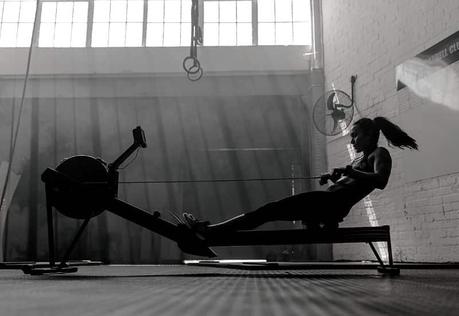
Rowing Machine vs Treadmill: How They Compare in Key Categories
 Calories Burned
Calories Burned

It’s always good to start off with the basics: calories.
Weight loss is an incredibly complex process, controlled by a number of factors—from diet to exercise to hormone and brain function to genetics.
However, for the sake of simplicity, it can be (sort of) boiled down to a single formula:
Calories burned > calories consumed = weight loss
As long as you’re expending more calories on your daily activities (including your workouts) than you’re eating, you will see results.
Trainer’s Note:
Some workouts will burn more energy over longer periods of time, while others will only burn calories during and immediately following the training.
But we’re keeping it simple in this article and focusing on the number of calories you burn during the workouts.
According to the experts, in 30 minutes of training:
- A slow walking workout on the treadmill will burn between 107 and 159 calories
- A steady job workout on the treadmill will burn between 180 and 252 calories
- A moderate-paced workout on the rowing machine will burn between 210 and 294 calories
- A 5 MPH running pace on the treadmill will burn between 240 and 336 calories
- A vigorous rowing machine workout will burn between 255 and 440 calories
- A HIIT sprint training session (alternating between 5 and 8 MPH) can burn as much as 375 to 525 calories
Because of the amount of energy required to run, a HIIT or sprint training session on the treadmill will ultimately burn more calories than you could burn on the rowing machine at a moderate pace. But not a whole lot more than a row machine HIIT workout burns, as you saw above.
By comparison, a “moderate” pace, rowing burns visibly more calories than jogging and walking. Because of the number of calories burned on the rowing machine at the pace most trainees are likely to set, I’d give it the slight edge.
 Muscles Worked
Muscles Worked

This is another important factor to take into account when considering any machine.
If your only form of training is cardio machines (you don’t lift weights or do any bodyweight strength training), you’ll likely want a machine that works more muscles in order to improve your overall fitness.
On the other hand, if you’re mixing cardio training in with your resistance training (either as a “finisher” after a workout or on your day off from weightlifting/bodyweight training), using a machine that works fewer muscles can actually be a good thing.
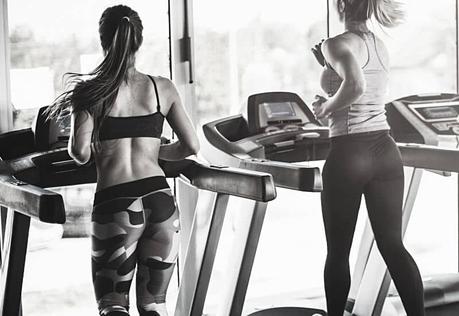
For example, let’s say you just hammered your upper back muscles on a “Pull Day” weightlifting session. The next day, those muscles need to rest, so you’ll want to avoid any machine that recruits them—in this case, the rowing machine.
Understanding which machines work which muscles is an important part of approaching your training the smart, effective way.
The list of muscles worked on the rowing machine is pretty long:
- Upper back
- Shoulders
- Biceps
- Forearms
- Abs
- Lower back/spinal supporters
- Glutes
- Hips
- Hamstrings
- Quads
- Calves
Really, the only muscles not worked are the “Push” muscles (your chest and triceps).
That’s one of the great benefits of rowing machines: it delivers a full-body workout.
The treadmill, on the other hand, is all about the lower body. The list of muscles worked are:
- Quads
- Hamstrings
- Glutes
- Calves
- Shins
- Abs and lower back (to keep you upright as you run)
Because of this, it’s much easier to build muscle with a rowing machine than with a treadmill.
 Functional Fitness
Functional Fitness

“Functional” fitness refers to fitness that translates into more efficient performance of your activities of daily life.
For example, running with your pets, playing with your kids, cleaning your garage, mowing your lawn, taking out the trash, and carrying in the groceries—all of these are activities of daily life that you don’t necessarily train for, but which become easier as your functional fitness increases.
There’s no argument here that the treadmill is, by far, the more functional of the two machines.
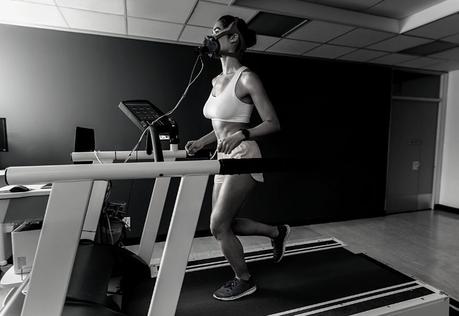
Whether you walk, jog, run, or sprint, the time you spend training on the treadmill makes it easier for you to move around the way you would every single day.
By comparison, the rowing machine is really only functional for one activity: water sports. Spending more time training on the rowing machine will help you to paddleboard, kayak, canoe, or row a boat more efficiently, but off the water, you won’t see huge improvements in other aspects of your functional fitness.
For this reason, I have to give the “W” to the treadmill in terms of functionality.
 Impact and Injuries
Impact and Injuries

When you’re young, your body is incredibly resilient and can recover from pretty much anything you throw at it in the course of your training and activity.
But as you age, things like impact, limited mobility, time spent sitting down, and incorrect form can begin to take a toll. Aches and pains become more common, as do injuries, and your body doesn’t heal quite as fast.
Why am I telling you all this? Simple: it’s so you know that as you age, you need to consider how much of a toll your workout can have on your body.
There are two aspects to take into account:
- Impact. Or, more specifically, the amount of wear and tear high-impact activity will put on your bones, joints, and muscles.
- Injuries. How likely an exercise is to cause injuries is definitely a factor you need to consider.
When it comes to impact, there’s no doubt that treadmill workouts are much higher-impact than rowing machine workouts.
On the rowing machine, you’re sitting down, so there’s really no impact at all. On the other hand, walking, jogging, running, and sprinting on the treadmill puts all your weight down on the front foot. The faster you move, the higher the impact.
Trainer’s Note:
High-impact activities are crucial for strengthening your bones, muscles, and joints. The impact causes microscopic damage that your body has to repair, and by doing so, reinforces the damaged tissue.
However, only doing high-impact exercise may cause your body to deteriorate/break down faster. You need time for the tissue to be repaired, so alternating between low- and high-impact exercise is the best way to go.
When it comes to injuries, things get a bit less clear.
On the rowing machine, incorrect form can lead to muscle strains and even joint injuries. However, with the proper form, you’re unlikely to experience any of the usual rowing injuries: lower back pain, shoulder impingement, IT Band friction syndrome, and wrist extensor tenosynovitis.
On the treadmill, it’s fairly easy to stay injury-free when walking, but if you speed things up, the risk increases. You may lose your balance or trip while running, fall, and injure yourself. You might pull a hamstring while running or sprain your ankle if you place your foot wrong (it has happened to me!).
For both machines, the injury risk is roughly the same, though there are different parts likely to be injured by your training.
 Cost and Footprint
Cost and Footprint

These are both factors you need to account for if you’re setting up a gym at home.
Cost-wise, it’s pretty easy to see why it matters: a pricier machine may be out of your budget, but a “cheap” machine may not deliver what you need.
Rowing machines are, surprisingly, often cheaper than treadmills—especially the higher-end models.
Rowing machines tend to be “simpler” in terms of mechanisms and functionality, with fewer moving parts and complex technical components at risk of breaking.
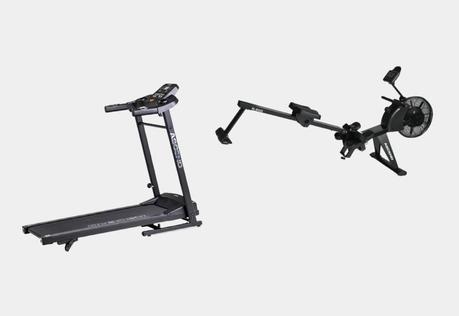
Treadmills, on the other hand, have lots of motors and servos and systems that cost more to manufacture to high standard of quality.
Footprint matters when you’ve got a limited space to work with, such as if setting up a home gym in your garage, living room, or basement.
There are a number of types of rowing machines that can be stored upright with a very small footprint, then lowered when it’s time to work out. Though some treadmills have this same feature, the footprint is significantly larger even when folded upright in storage position.
When in use, the treadmill is usually significantly wider than the rowing machine, but rowing machines may be longer.
Which will be best for you will depend entirely on how much machine you can afford, and how much space you have to store it.
Rowing Machine vs Treadmill: The Final Verdict
The rowing machine is perfect for people who:
- Want a full-body cardio workout
- Prefer a user-friendly HIIT workout without needing to adjust buttons or settings
- Spend the warm months out on the water paddleboarding, kayaking, canoeing, and fishing
- Like burning calories even at a moderate pace
- Have limited space in their home gym and need a cardio machine that can be tucked away between workouts
The treadmill is perfect for people who:
- Want to run, jog, or sprint more efficiently
- Like high-impact workouts to strengthen their bones, joints, and muscles
- Like to walk long distances and enjoy watching TV or reading a book while they work out
- Have more space to work with and want a more versatile machine
The Bottom Line
As you can see, both cardio machines are excellent—it’s what you do with them that makes all the difference in the world. Used correctly, the rowing machine can be an amazing tool to build muscle and increase your overall fitness, while the treadmill can be a game-changing addition to any home gym.
The question is: which serves your needs best?
Which will you enjoy using more? Which will help you be faithful to your weekly workout program and burn those calories to lose weight? Which will give you the workout that feels best for your unique physiology?
If you can answer these questions, you’ll be one step closer to picking the right machine for you.
Once you know you’ve got the better option, all that’s left is to shop for the machine that suits your needs and fits your budget!
More Rowing Machine Guides and Articles
How to Use a Rowing Machine Like a Pro (and Common Mistakes to Avoid). Ready to tackle the rowing machine for your next workout? Here’s everything you need to know about how to use it like a pro, including some common mistakes people make on the rower.
What Muscles Does the Rowing Machine Work? (and Why You Should Use It). The rowing machine is a monster for burning fat and building muscle. Here’s a look at all the muscles worked on the rower, tips for changing it up, and more.
